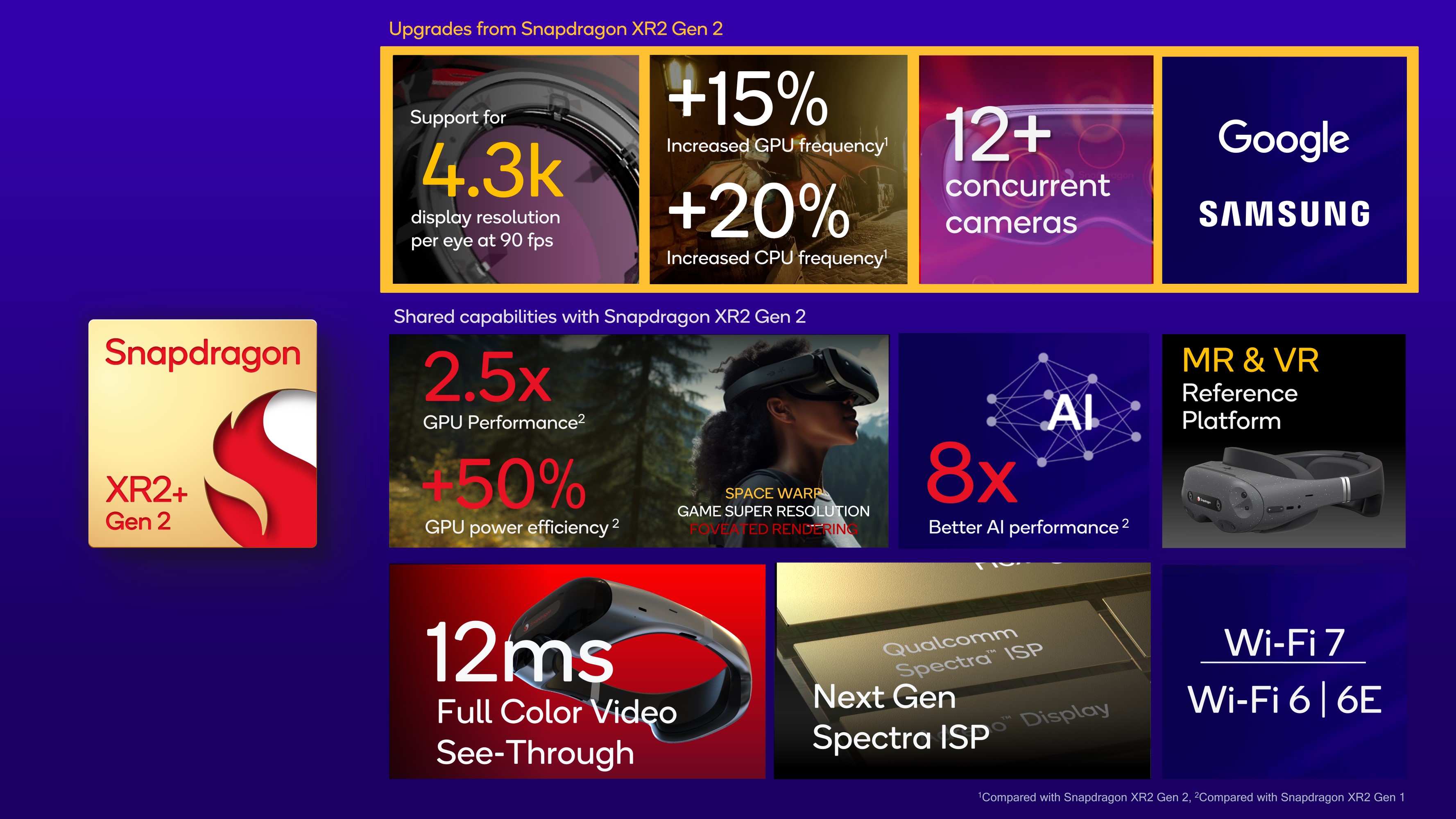New Snapdragon XR2+ will help Samsung outclass the Meta Quest 3
Qualcomm promises 4.3K per eye, a 20% CPU boost, and 2.5x GPU performance, all bound for Samsung's 2024 mixed-reality headset.

What you need to know
- Qualcomm announced the new Snapdragon XR2+ Gen 2, the revamped version of the XR2 Gen 2 found in the Meta Quest 3.
- It promises higher resolution, more cameras, higher clocking, and full-color passthrough.
- At least five brands will use the Snapdragon XR2+ Gen 2, including Samsung, HTC Vive, Immersed, and Play for Dream.
Samsung's long-rumored mixed-reality headset, possibly called Samsung Glasses, is expected to arrive soon. Now, thanks to Qualcomm, we know what kind of performance we can expect, with the Meta Quest 3's chipset as a benchmark.
The Snapdragon XR2+ Gen 2, announced on January 4, achieves some significant gains over the Quest 3's standard Snapdragon XR2 Gen 2, especially visually.
The new, upgraded chipset powers a max benchmark of 4,300 x 4,300 resolution per eye; even if no actual headset hits that number, it's still well above the Quest 3's 2,064 x 2,208 pixels per eye.
Qualcomm also promises the Snapdragon XR2+ Gen 2 hits 20% and 15% higher CPU and GPU frequency, respectively, compared to the XR2 Gen 2.
For context, the XR2 Gen 2 is no slouch; some of the stats in the chart above — like 2.5X GPU performance, 12ms full-color passthrough, and 8X better AI performance — apply to both the XR2 and XR2+, compared to the Snapdragon XR2 Gen 1 found in the Oculus Quest 2. In other words, this mid-gen upgrade won't significantly boost every benchmark.
One significant XR2+ upgrade is its support for 12 concurrent cameras instead of 10. Those two extra cameras should help enable eye tracking for foveated rendering, something the Quest 3 was unable to support but Qualcomm's XR2+ reference design headset does.
Qualcomm says that Samsung, HTC Vive, Immersed, Play for Dream, and an unannounced fifth OEM already plan to use the Snapdragon XR2+ Gen 2 for their headsets; we'll find out who the mystery XR2+ partner is during CES 2024.
Get the latest news from Android Central, your trusted companion in the world of Android
Of these, the Samsung Glasses should generate the most excitement. The only question is whether the Snapdragon XR2+ Gen 2 can deliver the power necessary for Samsung to compete with Apple for a higher-end productivity device.
"With Samsung's mobile expertise and our joint commitment, we aim to create the best-in-class XR experience for Galaxy users," Inkang Song, Samsung VP and head of technology strategy, said in Qualcomm's press release.
Samsung originally intended to launch its mixed-reality headset in 2023, but delayed it after the Apple Vision Pro launch because its original prototype would look deficient by comparison. It partnered with Qualcomm to develop the hardware and with Google for the XR software.
The current rumor is that Samsung only intends to make about 30,000 Samsung Glasses headsets, well below Apple's 400,000 target for the Vision Pro.
Whatever the case, Qualcomm hinted that an announcement about the headset should come soon — possibly at Galaxy Unpacked 2024, though Samsung typically only focuses on its flagship smartphones like the Galaxy S24. At the moment, you can receive $50 of Reserve Credit towards a Samsung smartphone, but there's no hint about an XR device.

Michael is Android Central's resident expert on wearables and fitness. Before joining Android Central, he freelanced for years at Techradar, Wareable, Windows Central, and Digital Trends. Channeling his love of running, he established himself as an expert on fitness watches, testing and reviewing models from Garmin, Fitbit, Samsung, Apple, COROS, Polar, Amazfit, Suunto, and more.

